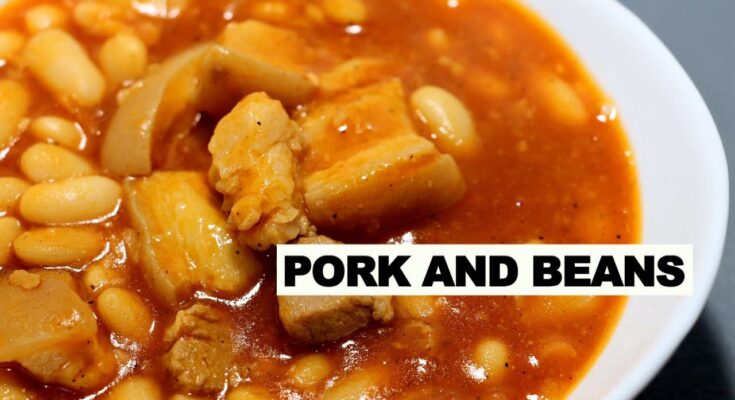Pork and Beans Recipe: Pork and beans—it’s one of those dishes that instantly brings warmth to your soul. Whether you’re reminiscing about your grandma’s cooking or just craving something hearty and satisfying, pork and beans checks every box. It’s packed with protein, has a rich, savory flavor, and is surprisingly easy to make at home. This dish has comfort written all over it. Imagine a bowl full of tender pork pieces nestled among creamy beans, all swimming in a flavorful, slightly sweet tomato-based sauce. It’s simple, yet incredibly fulfilling.
Beyond the taste, pork and beans also stands out for its versatility. You can serve it as a main course, a side dish, or even as part of a cookout spread. Plus, it’s budget-friendly—perfect for feeding a crowd without breaking the bank. The slow simmering process melds all the flavors beautifully, creating a dish that’s both rustic and heartwarming.
Origin and Popularity of Pork and Beans
You might be surprised to learn that pork and beans has quite a bit of history behind it. The dish dates back to early American colonial times, influenced by both Native American cooking techniques and European ingredients. Over time, pork and beans became a staple in American households—especially during hard times like the Great Depression—because it was affordable, easy to store, and filling.
Today, you’ll find variations of pork and beans around the globe—from Filipino-style with a slightly sweeter twist, to smoky Southern renditions that use bacon or ham hocks. It’s one of those dishes that has evolved but never gone out of style. Canned versions are popular for convenience, but making it from scratch? That’s where the magic truly happens. You control the seasoning, the texture, and the love that goes into every bite.
Ingredients You’ll Need
Main Ingredients
To get started on your pork and beans journey, gather the following ingredients:
- Pork: About 1 lb of pork shoulder or pork belly, cut into bite-sized pieces
- Beans: 2 cups of cooked white beans or 1 can of navy beans (drained and rinsed)
- Tomato Sauce: 1 cup of tomato sauce or crushed tomatoes
- Onion: 1 medium, chopped
- Garlic: 3 cloves, minced
- Brown Sugar: 2 tablespoons
- Salt and Pepper: To taste
- Water or Broth: About 1 cup, for simmering
These ingredients form the base of your pork and beans. If you’re aiming for authenticity and depth of flavor, go for fresh ingredients. Pre-cooked or canned beans are totally fine if you’re short on time, but make sure to rinse them well to reduce excess sodium.
Optional Add-Ins for Extra Flavor
Want to elevate your pork and beans to gourmet level? Try these optional ingredients:
- Smoked Paprika: Adds a rich, smoky flavor
- Bay Leaf: One or two, for added aroma
- Worcestershire Sauce: Just a splash for a umami boost
- Mustard: A spoonful of Dijon or yellow mustard gives it a tangy kick
- Bacon: For a smokier taste and crispy texture
- Molasses: A traditional ingredient that brings sweetness and depth
You can also tweak the recipe depending on your dietary needs. Want it sweeter? Add more brown sugar. Prefer a spicier version? Throw in some chopped jalapeños or chili flakes. The beauty of pork and beans is that it’s forgiving—there’s room to experiment and customize.
Step-by-Step Cooking Instructions
Step 1: Prepping the Ingredients
Before turning on the heat, make sure everything is prepped and ready to go. Chop your onions and garlic, cube the pork, and have your spices measured out. If you’re using dried beans, soak them overnight and cook them until tender. Using canned beans? Drain and rinse them thoroughly to avoid a salty taste.
This step might seem basic, but it’s the foundation of a smooth cooking process. The last thing you want is to overcook your pork while searching for the garlic! So take your time, lay everything out, and prepare for a seamless cooking experience.
Step 2: Cooking the Pork
Now let’s get into the heart of this dish—cooking the pork. In a large pot or Dutch oven, heat a couple of tablespoons of oil over medium heat. Once hot, toss in your pork cubes. You’ll want to brown them nicely on all sides to lock in that rich flavor. Don’t rush this part—let the pork sear properly, creating those golden bits at the bottom of the pan, which will later enhance the overall taste of the dish.
Once the pork is browned, remove it from the pot and set it aside temporarily. In the same pot, add your chopped onions and cook until translucent, about 5 minutes. Then, stir in the garlic and cook for another minute or two until fragrant. This forms the aromatic base of your pork and beans.
Now bring the pork back into the pot. Add the tomato sauce, brown sugar, and a bit of salt and pepper. Stir well to coat everything evenly. Then, pour in your water or broth and bring it to a gentle simmer. The mixture should look saucy but not soupy. Let it simmer for about 15-20 minutes to allow the pork to begin tenderizing and soak up the delicious flavors.
Step 3: Adding the Beans and Simmering
Once your pork has had time to cook down a bit, it’s time to bring in the beans. Add them to the pot and stir gently so they don’t break apart. Reduce the heat to low, cover the pot, and let everything simmer for another 20-30 minutes. This slow simmering is where the magic happens. The pork gets more tender, the beans absorb the tomato and pork juices, and the entire dish thickens into that iconic pork and beans consistency.
Keep an eye on the pot during this time. Stir occasionally to prevent sticking or burning at the bottom. If the mixture looks too dry, add a splash of water or broth. If it’s too soupy, take the lid off and let it reduce until you hit that perfect thickness.
This step is all about patience. The longer it simmers, the better the flavors meld. So go grab a coffee, relax, and let your kitchen fill with the irresistible aroma of home-cooked comfort food.
Step 4: Final Touches and Taste Adjustments
Now that your pork and beans are simmering beautifully, it’s time to fine-tune the flavors. Taste the sauce and adjust the seasoning. Need more salt? A dash of Worcestershire sauce? Maybe a bit more sugar if you like it sweeter? Go ahead and tweak until it’s just right for your taste buds.
You can also stir in a bit of mustard or a splash of vinegar at this stage for a touch of acidity to balance out the richness. If you’ve added bacon, toss it in now for an extra smoky bite. Simmer for a final 5-10 minutes uncovered to let those last flavors blend perfectly.
Once satisfied, turn off the heat and let the dish rest for a few minutes. This helps everything settle and intensifies the flavors even more. And there you have it—a pot of rich, hearty, homemade pork and beans that’s sure to impress anyone at the dinner table.
Cooking Tips and Tricks
Best Pork Cuts for Pork and Beans
Choosing the right cut of pork can make or break your dish. For a melt-in-your-mouth texture, go for pork shoulder or pork belly. These cuts have enough fat to stay juicy and tender during long cooking times. Pork loin or tenderloin can be used in a pinch, but they tend to dry out if overcooked.
Want a more rustic, meaty texture? Pork ribs or even smoked ham hocks bring incredible flavor and richness, especially if you’re cooking the dish low and slow. Don’t forget to trim excess fat, but leave enough to keep the pork juicy and flavorful.
How to Make It More Flavorful
If you really want to elevate your pork and beans, here are a few tricks:
- Caramelize the onions before adding garlic to bring out their natural sweetness.
- Use smoked paprika or chipotle powder for a smoky, earthy depth.
- Deglaze the pot with a splash of white wine or apple cider vinegar after searing the pork for extra complexity.
- Cook low and slow. The longer it simmers, the deeper the flavor.
- Add herbs like thyme or bay leaves for subtle aromatic layers.
And remember, don’t skip the taste test before serving—it’s the best way to ensure you’re serving a dish that’s seasoned to perfection.
Serving Suggestions
What to Serve with Pork and Beans
So, your pork and beans are ready, simmering away in a rich, savory-sweet sauce. Now comes the fun part—deciding how to serve it! This dish is incredibly versatile and pairs well with a variety of sides that complement its hearty nature.
- Steamed white rice: This is a classic pairing, especially in many Asian households. The neutral flavor of rice soaks up the flavorful sauce, making each bite more satisfying.
- Cornbread or dinner rolls: For a Southern twist, serve your pork and beans with freshly baked cornbread or soft rolls. The sweetness of cornbread perfectly balances the rich, savory beans.
- Mashed potatoes: Creamy mashed potatoes act as the perfect base for pork and beans, turning it into a comfort-food feast.
- Grilled vegetables: To lighten things up a bit, add a side of grilled zucchini, bell peppers, or asparagus. They bring a refreshing balance to the richness of the pork.
- Coleslaw: For something cool and crunchy, coleslaw adds a tangy contrast that cuts through the heavy flavors of the beans and pork.
You can also serve pork and beans as a side dish for grilled meats during a barbecue, or tuck them into a sandwich roll for a fun, messy, and delicious sloppy joe-style meal.
Storage and Reheating Tips
Got leftovers? No problem! Pork and beans store incredibly well and even taste better the next day as the flavors continue to meld.
Storage Tips:
- Let the dish cool completely before transferring it to an airtight container.
- Store in the refrigerator for up to 4 days.
- For longer storage, portion it into freezer-safe containers and freeze for up to 3 months.
Reheating Tips:
- To reheat on the stove, place in a saucepan with a splash of water or broth to loosen the sauce. Heat over medium, stirring occasionally until warmed through.
- In the microwave, cover loosely and heat on medium power in intervals, stirring in between to ensure even heating.
Avoid overheating, especially in the microwave, as it can dry out the pork or make the beans mushy. Gentle reheating is the key to enjoying leftovers just like fresh.
FAQs about Pork and Beans Recipe
1. Can I use canned beans instead of dried beans?
Yes, canned beans are a great time-saver. Just make sure to drain and rinse them before adding to reduce excess sodium and improve flavor.
2. What’s the best pork cut for this recipe?
Pork shoulder or pork belly works best due to their fat content and tenderness. These cuts hold up well to slow cooking and provide rich flavor.
3. Can I make this recipe in a slow cooker?
Absolutely! Brown the pork and sauté the aromatics first, then transfer everything to a slow cooker. Cook on low for 6–8 hours or on high for 3–4 hours.
4. How do I make the dish vegetarian?
You can skip the pork and use smoked paprika or liquid smoke for a smoky depth. Add extra beans, mushrooms, or tofu for protein and texture.
5. Is pork and beans considered healthy?
It can be! Use lean pork, reduce the sugar, and add veggies like bell peppers or carrots to boost nutrition. Keep portion sizes balanced for a hearty yet healthy meal.
Conclusion
There you have it—the ultimate, no-fail, step-by-step guide to making hearty, flavorful pork and beans right in your own kitchen. Whether you’re a seasoned home cook or just getting started, this dish is approachable, forgiving, and endlessly satisfying. It’s the kind of recipe that doesn’t require fancy techniques or hard-to-find ingredients. With a bit of time and love, you’ll end up with a dish that’s rich, savory, slightly sweet, and packed with comforting goodness.
The beauty of pork and beans lies in its versatility. You can customize it to suit your taste, make it spicy, smoky, sweet, or even toss in some veggies to make it healthier. Serve it with rice, bread, or eat it straight from the pot—it’s all good! Plus, it stores well, making it perfect for meal prep or batch cooking.
So next time you’re craving a warm, soul-satisfying meal, give this pork and beans recipe a shot. It’s simple, it’s delicious, and best of all, it brings people together around the dinner table—just the way food should.



